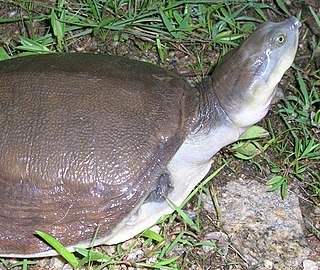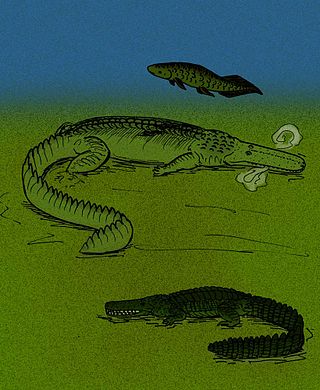
Carcharhinus is the type genus of the family Carcharhinidae, the requiem sharks. One of 12 genera in its family, it contains over half of the species therein. It contains 35 extant and eight extinct species to date, with likely more species yet to be described.

Lissemys is a genus of softshell turtles in the subfamily Cyclanorbinae of the family Trionychidae. The genus is indigenous to southern Asia.
Brevidorsum is an extinct genus of dissorophoidean euskelian temnospondyl within the family Dissorophidae.
The Deseadan age is a period of geologic time within the Oligocene epoch of the Paleogene to the Early Miocene epoch of the Neogene, used more specifically within the SALMA classification of South America. It follows the Tinguirirican and precedes the Colhuehuapian age.
The Laventan age is a period of geologic time within the Middle Miocene epoch of the Neogene, used more specifically within the SALMA classification in South America. It follows the Colloncuran and precedes the Mayoan age.
The Huayquerian age is a period of geologic time within the Late Miocene epoch of the Neogene, used more specifically within the SALMA classification. It follows the Chasicoan and precedes the Montehermosan age.

Retodus is an extinct genus of prehistoric lungfish found in Cretaceous-aged freshwater strata of Egypt, Algeria and Niger. The type species, R. tuberculatus, was named in 2006. It was originally named as a species of Ceratodus and Neoceratodus in 1963.

Chelonoidis is a genus of turtles in the tortoise family erected by Leopold Fitzinger in 1835. They are found in South America and the Galápagos Islands, and formerly had a wide distribution in the West Indies.
Wintonopus is an ichnogenus of dinosaur footprint. Its footprints have been found at Lark Quarry in Queensland Australia. The genus is named after the Winton Formation in which the tracks were found. Other tracks were found in the Broome Sandstone of Dampier Peninsula, Western Australia.
Liptornis is a genus of fossil birds of uncertain affinities. The type species is L. hesternus. It was described by Argentine palaeontologist Florentino Ameghino in 1894 from a large cervical vertebra from the Middle Miocene Santa Cruz Formation of Patagonia. At the time, it was referred to the Pelecanidae, though this is questionable. In his 1933 palaeornithological review, Lambrecht referred it only to the superfamily Sulides without placing it in a family. A later study has suggested family Anhingidae.
Albanohyus was an extinct genus of even-toed ungulates which lived during the Miocene in Eurasia and possibly Africa.
Tetraconodon was an extinct genus of even-toed ungulates that existed during the middle and late Miocene in Asia.
Lopholistriodon was an extinct genus of even-toed ungulates that existed during the Miocene in Africa.
Helochelys is an extinct genus of stem turtle known from the Late Cretaceous (Cenomanian) of southern Germany.

Boreostemma is an extinct genus of glyptodonts from northern South America. Fossils assigned to the genus were first described as belonging to Asterostemma from southern South America, but have been placed in the new genus Boreostemma by Carlini et al. in 2008. The type species is B. pliocena. Fossils of Boreostemma have been found in the Honda Group of Colombia, in Peru and Venezuela.

Miocochilius is an extinct genus of small notoungulate mammals (typotheres) native to South America. The genus lived during the Middle Miocene epoch. The genus contains two described species, the type species M. anomopodus described in 1953 by Ruben Arthur Stirton and M. federicoi, described and included in the genus by Darin A. Croft.
Simpsonotus is an extinct genus of notoungulate mammals in the family Henricosborniidae from the Middle to Late Paleocene of South America. Fossils of the genus have been found in the Mealla Formation, a fluvial and lacustrine sedimentary unit of the Salta Basin in northwestern Argentina. The genus name honors paleontologist George Gaylord Simpson.
Rhothonemys is an extinct genus of bothremydid pleurodiran turtle that was discovered in the Paleogene of Morocco. The genus consists solely of type species R. brinkmani.






